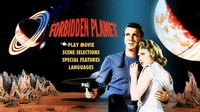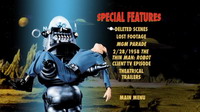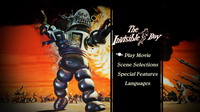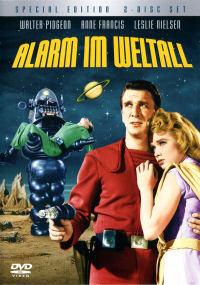
14.03.2017 #594
German Original from 28.8.2007
by Guido Bibra
• MGM Parade - Excerpts from two Episoides
• TV-Episode from 1958 "Robot Client" from The Thin Man
• Trailershow
• Complete 1957 movie "The Invisible Boy"
• Watch the Skies! Science-Fiction, the 1950er and Us
• Amazing! Explore the Far Reaches of Forbidden Planet
• Robby the Robot: Engineering an Science-Fiction Icon
![]() The Movie
The Movie
In the 23rd century interstellar travel has become reality. Commander Adams and his crew are tasked to travel with their C-57D spaceship to the far away planet Altair to find out what happened to an expedition that was sent out twenty years before. They encounter Dr. Morbius, one of the crew members, who at first is very reluctant to let them land on the barren planet where he and his daughter are the only survivors of the expedition...
At the beginning of the 1950s, sophisticated science fiction movies about alien life and travel in space and to other planets were far and few between. There were a few exceptions like The Day the Earth Stood Still or Destination Moon who treated the premises seriously, but the majority were quickly and cheaply produced horror shockers with a space theme, of which Jack Arnold's It Came from Outer Space and William Cameron Menzie's Invaders from Mars had been some of the better examples. Science fiction like it is known today in the shape of Star Wars, Star Trek or other space operas was still largely unknown - until two authors, Allen Adler and Irving Block, tried to get the movie studios interested into a completely new and untried idea.
Adler and Block had been working on a treatment with the title Fatal Planet since 1952, but they were unable to sell it to the major Hollywood studios because they refused to make a cheap and quick production out of their relatively serious and earnest story. Only Metro-Goldwyn-Mayer, one of the biggest film studio giants of the 1950s, had not yet joined the steadily growing wave of science fiction. They had been searching for an interesting concept though, which they found in Allen Adler's and Irving Block's treatment. Much to the delight of the authors, the studio was not interested in making a quick buck with their story, but instead promised a big and lavish production in the same manner as their famous musicals.
The story the authors had worked on was not just any usual science fiction tale, but based in part on William Shakespeare's The Tempest, with the plot set in far outer space on an alien planet and with condensed and modernized characters. While Allen Adler and Irving block supplied the original concept, they had no experience as script writers themselves and consented to give their idea to MGM's long time author Cyril Hume, who carefully fleshed out their treatment. The studio was very conscious about making the now re-titled Forbidden Planet something much better than what the competition had to offer and raise the bar considerably in the science fiction movie genre.
The story included elements which were completely new for the mid-1950s audience. So far it had mostly been the more or less evil aliens visiting the Earth in their flying saucers, often bringing fear and terror, but now Earthlings themselves were the ones making expeditions to alien planets. This wholly new concept, which before had only been seen in science fiction literature and had never been treated seriously in movies, became a big sensation and even resulted in a sort of revolution that had far-reaching implications for the film and television industry.
Forbidden Planet was headed by producer Nicholas Nayfack and director Fred McLeod Wilcox, an experienced and seasoned filmmaker, who had been working for MGM since the 1930s. He had, of course, not much been in contact with the science fiction genre and had never worked in the then brand-new Cinemascope widescreen format, resulting in a slightly wooden and conventional staging. Wilcox and his cinematographer George J. Folsey, another industry veteran probably did not want to take too many risks with the camerawork and the acting and so they shot the movie almost like a theatre production. This would have been the biggest handicap of the movie if there wouldn't have been the sensational visual effects - the never before seen look and the very expressive actors actually go hand in hand with the no-nonsense and even somewhat dry direction.
MGM pulled out all the stops for the casting of Forbidden Planet and brought out some of its biggest stars, headed by studio veteran Walter Pidgeon. One of the great character actors of his time, Pidgeon plays the mysterious Dr. Morbius as a benevolent grandfather figure with a dark side and takes the role entirely serious, giving the movie the much needed straight undertone. While Walter Pidgeon was at this point of his already decades-spanning career not adverse to doing comedy, he treats his character completely earnestly, making Morbius surprisingly realistic. Some of his text, especially the science-fiction-heavy monologue, would have been too much for any other actor of the time, but Pidgeon wholly embodies his Dr. Morbius, making him the strong centrail point that Forbidden Planet needs.
For the role of Morbius' daughter Altair the Fimmakers were searching for the cliche of an innocent, young, blonde beauty and a couple of years before would probably have chosen the young Marilyn Monroe - but the actress had meanwhile established herself as the greatest sex symbol of the 1950s and also was under contract at 20th Century Fox. Instead, the role went to the 25-year-old Anne Francis, who had already been in front of television and film cameras for a decade and proved to have exactly the right charisma for the young and naive Altair. On first glance, she looks like an entirely thankless superficial character, but like her co-star Walter Pidgeon, Anne Francis tool her role serious enough not to make it embarrassing or laughable.
The dashing spacehip commander John J. Adams was played by a young actor called Leslie Nielsen in only his second film role after many theatre and television appearances. The handsome, serious leading actor was the same who decades later switched from drama to comedy, becoming one of the most-loved comedians of the 1980s and 1990s, but in Forbidden Planet there was absolutely nothing of that noticeable yet. As a fair and intelligent, yet sometimes reckless and adventurous commander he was a prototype of all spaceship captains, most of all, of course, Captain Kirk of the Enterprise almost exactly a decade later. Leslie Nielsen's no-nonsense approach gave Forbidden Planet a lot of authenticity, emphasizing the militaristic command structure on his spaceship without neglecting the human factor - Adams is not a dictator, but a nice guy who knows how to handle his crew, even though he might be sometimes out of depth with Morbius and his alluring daughter.
The somewhat wildwest character of the Bellerophon's crew is further underlined by some of the supporting cast: there's of course a ship's doctor - played unspectacularly, but solid by Warren Stevens - who is at the same time the best buddy of the Captain, something which would continue to be a staple of later science fiction. The other crew is entirely forgettable and blends into a background of grey uniforms - with the exception of one comedic diversion in the shape of the ship's cook, played to the hilt by Earl Holliman in one of his earliest film roles, whose main concern is finding genuine earth firewater, getting help from a surprising source. His character doesn't really have any function in the plot and seems shoehorned into the script to create some comedic diversion, but Holliman's short appearance is actually fun to watch.
Forbidden Planet's main claim to fame was that its real star was a special effect - Robby, the robot, constructed by Japanese-American production designer Robert Kinoshita and built with a then astronomical budget. He was not a model, but the first life-size robot in film history properly interacting with people in front of the camera. With his numerous technical gadgets and gimmicks on display, Robby was the ultimate embodiment of science fiction, even though he was not even remote controlled - he was moved from within by actor Frankie Darrom, but he was much more than just a costume.
Robby was, of course, mainly meant as a technical gimmick to enhance the science-fiction aspect of the movie, but he also was something of a humorous element. With the unmistakable voice of Marvin Miller, dubbed in during post-production, Robby has the mannerisms of an English Butler, creating a lot of opportunities for comedic diversions, which the script actually manages not to overuse. Robby is also the reason that a version of the Three Laws of Robotics, first formulated by Isaac Asimov in the 1940s in one of his early short stories, make their first film appearance in Forbidden Planet - those are discussed at length in one of the film's scene, bringing the audience up to speed on Robby's safeguards. The iconic movie poster may portray him as a kind of monster - the depicted scene of him carrying what seems to be Altair doesn't exist in the movie - but in the story he is no menace but a benign and useful machine that actually saved the day in the end.
Robby was at least as expensive as his fellow flesh-and-blood actors, if not more - his enormous construction and operating costs made it necessary for MGM to use him in more movies and television series, but he never had such a classy appearance as in Forbidden Planet. Only one year after his debut he returned in the quickly shot B-movie The Invisible Boy, but the plot had absolutely nothing to do with the predecessor and was quickly forgotten, only later to surface as a curiosity again. Robby's further appearances were more of a novelty nature - he was a guest on several television series and he never completely vanished, but his one great legacy was just his part in Forbidden Planet. Today the original Robby is in the hands of a collector, but he was several times rebuilt and is still one of the great non-human stars of science fiction.
Forbidden Planet also paved completely new ways for special and visual effects - it was, of course, not by far the first movie making use of effects, but the first ones to do so on a really big scale. The ambitious production was headed by A. Arnold Gillespie, the long-time head of MGM's effects department, who had worked on movies as early as the 1925 incarnation of Ben-Hur. He and his team created the most astonishing special effects of its time which only would be surpassed more than a decade later with Stanley Kubrick's 2001: A Space Odyssey. Forbidden Planet did not beat around the bush for long and delivered the goods directly in the first few minutes of the movie - a mix of traditional animation, model shots and matte painting depicted the breathtaking arrival of the spaceship on the alien planet. Thanks to the generous budget, the effects did not disappoint in 1956 and even hold up until today.
The spaceship itself was still designed in the traditional shape of a flying saucer and did not only exist as a small model for special effects shots, but also as a life-size version that was 3/4th partially built for the 'exterior' shots, which actually were done completely under the roofs of MGM's Culver City studio. While even the bridge of the starship was completely built as a lavish, life-size set, the futuristic Krell laboratories and power stations deep inside the planet were, of course, only possible with the help of matte paintings and animations - but even those were so well combined with the real-life shots of the actors that they looked surprisingly realistic.
Although Forbidden Planet was not meant to be a horror movie, the story did come with its own monster - and it was not an alien or a robot at all, but a mysterious metaphysical manifestation that was to stay mostly invisible in a very suspenseful and creepy way. The monster was only to appear briefly once, but at first the filmmakers were unsure how to do accomplish this until they were able to get help from the competition: Joshua Meador, one of Disney's best animators, was recruited to work on the monster appearance and a few other scenes. He solved the problem in a relatively easy and cost-effective way by not using full cel animation, but simply pencil drawings which were then copied directly on a negative and combined with the on-set footage.
Originally, MGM had planned to fit Forbidden Planet with a classical film score that was to be composed by David Rose and Harry Partch. At the end of 1955, only a few months before the movie's premiere, Rose had already composed a title tune, but then MGM producer Dore Schary stumbled upon the young couple Louis and Bebe Barron, who had been experimenting with electronic sound creations since the early 1950s. They were immediately hired to create a few sound effects for the movie, but when they had completed their first tracks, the filmmakers were so amazed that the traditional film score was abandoned and Louis and Bebe Barron were hired to 'score' the whole movie.
At a time when the synthesizer was still about a decade into the future, It was the first time that electronic sounds had used in a big-budget film production - something like this had neven before been heard in a cinema. Louis and Bebe Barron created their score, which was only music in a very loose sense, with the help of complex electronic circuits, which they assembled on the basis of a mathematician's equations. All their sound experiments were immediately recorded on magnetic tape because they were only rarely able to reproduce them a second time.
The soundtrack of Forbidden Planet was finally edited together from their countless recordings, which were much less random than their unique method suggests. The Barrons did not compose a classical film score out of notes, but they still used their electronic circuits like instruments and choreographed their worlds of sound in minute detail to the plot of the movie. Nevertheless, they did not receive credit as composers in the opening titles because they were no members of the film musician's guild, who even refused to recognize them. But in the end, they did receive their big credit after all as creators of the Electronic Tonalities of the movie - which was actually the special recognition they deserved.
The first test screenings of Forbidden Planet were reportedly so overwhelmingly positive that MGM decided to rush through the rest of the post-production and release the movie as it was into the cinemas. A few hasty cuts for timing were made, resulting in a sometimes slightly off-kilter dramaturgy and at least one very obvious jump cut in the final scenes, but this did not hurt the long-term success of the movie. Even though, at first Forbidden Planet did not prove to be the great blockbuster it could have been, because in Spring 1956 the cinema audience was still wary of too many cheap science-fiction movies.
The movie did still turn in a solid profit and after the almost unrelated and entirely forgettable semi-sequel The Invisible Boy was made in 1957, again produced by Nicholas Nayfack, there was more than just talk about a real sequel. Writer Irving Block had teamed up with none other than Isaac Asimov on another science-fiction movie called Kronos and afterwards began to work with him on a treatment called Robot Planet, which would have Commander Adams and his spaceship land on a planet ruled by robots who enslaved the human population. The project had advanced as far as the pre-production stage at the beginning of 1958 and plans were made to reassemble the creative crew and most of the cast of Forbidden Planet to start production on the sequel, but at the end of March producer Nicholas Nayfack had unexpectedly passed away, leaving Robot Planet in limbo. Without a driving force behind it, the project lingered at MGM until Summer 1958, when it was unceremoniously cancelled by the studio - all resources were needed for Ben-Hur instead.
Even without a true sequel, Forbidden Planet had slowly found a whole new audience since the second half of the 1960s and the newly invigorated science fiction genre - it had finally become the genre classic that had started it all. The young, aspiring filmmakers, who had seen the movie in their childhood on the big screen or on television had now started to make film and television themselves and it is no understatement to say that without Forbidden Planet, there would have been no Star Trek, no Star Wars and many other science fiction franchises. Especially Star Trek creator Gene Roddenberry was so heavily influenced by the movie that Forbidden Planet today feels like the first proto-episode of his series - a connection that he never denied and wholeheartedly embraced.
Today, Forbidden Planet is still sometimes unfairly categorized into the mass of cheap 1950s science-fiction b-movies, but it actually holds up surprisingly well and was one of the few really positive examples of proper science fiction of its time. Its speculative nature and refusal to resort to cheap thrills in favour of a proper story with actual scientific merit - what would later be known as hard science fiction - makes it absolutely unique and a classic in its own right. Even over sixty years after its making, Forbidden Planet is still ageing well as the first serious science fiction movie in film history.
![]() The DVD
The DVD
Forbidden Planet had first been released on DVD in 1998 in Region 1, which even back then had a pretty impressive image quality, but no substantial extras. It took a couple of years until the 50th Anniversary in 2006 for Warner had pulled out all the stops and not only restore the movie, but also produce a solid collection of bonus materials.
The new Forbidden Planet DVD had been released in two different editions worldwide: as a 'simple' 2-disc Special Edition and as an Ultimate Collector's Edition containing the two discs from the SE, a lot of historic print material and a small replica of Robby the Robot, all housed in an elaborate tin box. The movie was also simultaneously released on HD-DVD in 2006 with the same extras and there was even an HD Ultimate Collector's Edition, but after the format wars had decided for Blu-Ray, it took Warner four years until 2010 to release Forbidden Planet on BD. All discs are sourced from the same restored high-definition transfer and contained virtually the same extras.
I had decided to get the less expensive German 2-disc set back in 2007 and even though this version only comes in a simple keepcase without a booklet or other printed extras, the discs themselves are identical to all the other versions out there and still represent the best home video representation of Forbidden Planet you can get - except the Blu-Ray, of course.

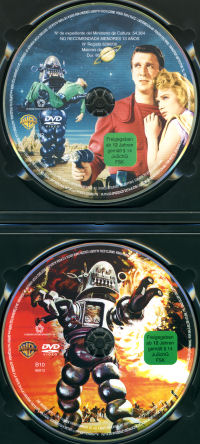
![]() Image
Image
For the 50th Anniversary of Forbidden Planet in 2006, Warner had restored the movie to its full glory, making the difficult source material look much younger than half a century old. It is often erroneously assumed that Forbidden Planet was originally shot in the 2.55:1 CinemaScope ratio, but in 1956, three years after the introduction of the anamorphic widescreen system, everyone had long switched to the now familiar 2.35:1, which is represented in this new transfer as 2.40:1, probably opening up the sides a little bit.
The film source looks remarkably good and had been very thoroughly, but not completely cleaned. On closer inspection, there are still a few isolated dirt and dust particles visible, but those are still within reasonable limits and do not distract at all. The film grain was not removed at all and is more or less constantly visible depending on the nature of each scene with special effects sequences being a bit more grainy than normal. This way the movie looks refreshingly alive and not like a digtal filtered mess. Sharpness is excellent too, especially for a CinemaScope movie of this age. While the image seems to be a little bit soft on first glance because no additional sharpening filters have been applied, there is an amazing amount of detail visible. Like the grain level, sharpness varies a little bit depending on the nature of the scene.
The colours have been reconstructed as good as possible, almost completely removing the green-yellowish tint some of the earlier transfers were plagued with. Because the 1950s Eastmancolor process is notoriously difficult to colourtime, the success was not quite one hundred percent - sometimes the colour of the grey uniforms suddenly changes a little bit and flesh tones are not all that constant either. The typical pastel-like colour timing has still been remarkably well preserved considering the age of the movie, though.
The only visible distraction of the new transfer comes from the source material itself and is not really fixable: all opticals and cross-fades still stand out like sore thumbs because those are at least one dupe generation further away from the master and look accordingly grainier and less detailed. The new restoration has minimized those differences to a certain degree, but without completely re-assembling the movie - which would probably impossible because all the source material is probably long gone - this is as good as the movie will ever look.
Thanks to Warner's restoration efforts, Forbidden Planet now looks again as good or even better as it did on its premiere in 1956. A few age-related limitations like the not quite perfect colour timing and the occasional dust particles are hardly noticeable even on large screen sizes.
![]() Sound
Sound
The sound format of the original Forbidden Planet release in 1956 has been the subject of many debates, but the release of the new DVD in 2006 made clear that there were indeed prints with four magnetic tracks in addition to less expensive ones only with optical mono sound. The four-track master had already been used for the 2.0 surround track of the previous DVD release, but the new edition features a discrete track sourced from the original mag tracks.
The English soundtrack is listed as Dolby Digital 5.1, but it seems to be more an adaption of the original magnetic track mix with three front and one rear channel. While Forbidden Planet is certainly a true science-fiction movie, the listener should certainly not expect a modern surround spectacle - but the soundtrack is still surprisingly active and much more than just an enhanced mono.
The first surprise is the high directionality of the dialogue, which makes the voices follow the actors on the wide CinemaScope image, reproducing this back-then novel method of dialogue mixing in full authenticity. The sound effects, consisting in large parts of Louis and Bebe Barron's "Electronic Tonalities", are sometimes limited just to the center channel, but often spread out over the frontal soundstage and even use the surrounds on occasion. The mix is still very much in the spirit of the 1950s, with sound engineers either going completely overboard or, in this case, mixing surprisingly conventionally.
The overall sound is surprisingly clean and undistorted, with only a slight background hiss, which is preferable to a tinny, filtered soundtrack. Frequency and dynamic range have, of course, age-related limitations, but do not appear overly distracting. Even the sometimes a bit shrill electronic music sounds much less biting and scratchy than on earlier mixes. Even the dialogue has a surprisingly good quality, sounding much less tinny than on many other movies of this age.
Unfortunately Warner has made practically no restoration efforts for the German and Spanish mono soundtracks. The German version is still somewhat acceptable, but the voices sound extremely thin and exhibit loud hissing on all s-noises, pointing to a badly transferred optical track. The Spanish version sounds even worse in all respects.
![]() Extras
Extras
For the Special Edition of Forbidden Planet, Warner had made a big effort digging up a lot of fascinating and rare material from the archives, some of which had never been seen before. The absence of an audio commentary may be disappointing at first, but the documentaries, featurettes and even deleted scenes more than make up for that - not to mention the inclusion of another whole movie and an episode of a television series. The menus are not animated, but the still shots have been lovingly designed in the spirit of the movie.
Disc 1 contains Forbidden Planet itself and the first part of the extras.
The Deleted Scenes (13:13) have been sourced from a workprint, which evidently has only survived as a very fuzzy videotape, but at least the original aspect ratio has been preserved. The terrible quality does not, however, make these scenes any less interesting - some had been entirely removed from the movie for timing reasons, others are extended versions of existing sequences, including the infamous jump cut at the end of the movie. All scenes are introduced by detailed text screens with lots of information.
Lost Footage (9:21) consists of eight test sequences from the special effects, which are presented in anamorphic 1.78:1 and look slightly better than the deleted scenes, but are still somewhat scratched and blurry. Unfortunately something seems to be wrong with the aspect ratio - this seems to be a 4:3 image stretched to 16:9, but it is unknown if the test footage was produced in 1.33:1 or if the scenes were pan&scanned from the CinemaScope original. The similarity to existing scenes in the movie sadly suggest the latter, but the scenes are still fascinating to watch. Like the deleted scenes, all sequences are introduced by informative text screens.
MGM Parade Excerpt from Episode 27 (2:16) and Episode 28 (3:58) are short excerpts from MGM's television program that was often used as a promotion platform for the studio's movies - here, Walter Pidgeon is pitching Forbidden Planet to the audience and is even joined by Robby the Robot in the second scene on the spaceship set!
The Thin Man: Robot Client (25:34) is a complete episode from the 1958 television series with Robby the Robot as a guest star. While it's not one of the best examples of 1950s US television, it's a nice curiosity and the image quality is quite good save for a slight videotape look and occasionally dust and scratches.
Theatrical Trailers has a nice themed collection from the Warner catalogue and doesn't even forget the main movie of the set: A Super Hero Like No Other - Superman (1:31), The Beast from 20,000 Fathoms (2:25), Them! (3:08), Forbidden Planet (3:40), The Invisible Boy (2:30) and The Time Machine (2:23) are all present in solid quality.
Disc 2 contains another whole movie and the three documentaries of the set.
The Invisible Boy (85:41) is the semi-sequel of Forbidden Planet from 1957, but it mostly amounts to an embarrassment not worthy of a separate DVD release. The movie was mostly made to recoup the enormous construction costs of the robot suit and has no real connection to Forbidden Planet save for Robby himself, so it really feels like a cheap cash-in. Warner has still done a decent anamorphic transfer, albeit without any digital cleanup resulting in a bit more dust and scratches than tolerable - but the quality is still much better than expected for such a curiosity. There is only an English soundtrack - either the movie was never released in Germany or Warner simply didn't bother to include any dubs -, but there are subtitles in English, German, Dutch and Spanish.
Watch the Skies! Science Fiction, The 1950s and Us (55:31) is an excellent documentary by film historian Richard Schickel about the science fiction wave of the 1950s that was originally produced for Turner Classic Movies in 2005. It features filmmakers George Lucas, Steven Spielberg, Ridley Scott und James Cameron reminiscing about the old classics of science fiction and the workings of the film industry. Everyone exhibits an amazing amount of film history knowledge, making this documentary a treasure trove not only for novices of the genre. Their appearances are supplemented by generous amounts of film clips and a nicely done voiceover by none other than Mark "Luke Skywalker" Hamill. While this is not the most profound and academic documentary of all times, it celebrates the most important factor of the genre - having fun watching the movies themselves and understanding how the genre developed over time. It's the perfect documentary for this DVD set.
Amazing! Explore the Far Reaches of Forbidden Planet (26:34) was newly produced for this special edition and despite its short length manages to document the development of the movie in great detail. New interviews with actors Anne Francis, Earl Holliman, Warren Stevens, Richard Anderson, Leslie Lielsen and composer Bebe Barron, as well as Roboter-Designer Robert Kinoshita bring a lot of amazing first-hand accounts of the making of the movie. They are joined by filmmakers John Landis, William Malone, Joe Dante and Joe Carpenter, special effects creators John Dykstra, Phil Tippet and Dennis Muren, authors Alan Dean Foster and Bill Warren, film historians Bob Burns and Rudy Behmler and sound designer Ben Burtt, who are also talking about the history of Forbidden Planet and its influence on the film industry.
Robby the Robot: Engineering an Science-Fiction Icon (13:45) takes a look at the electronic star of the movie. Robby's designer Robert Kinoshita, collector and director William Malone, the owner of the original suit and Fred "The Robot Man" Barton, who constructs life-size Robby replicas, tell all about how the most famous robot in film history was conceived, designed and manufactured.
